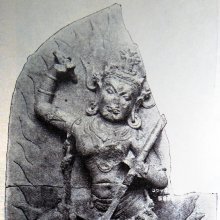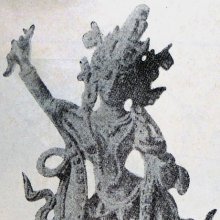Kanthika, Kaṇṭhikā: 14 definitions
Introduction:
Kanthika means something in Buddhism, Pali, Hinduism, Sanskrit, the history of ancient India. If you want to know the exact meaning, history, etymology or English translation of this term then check out the descriptions on this page. Add your comment or reference to a book if you want to contribute to this summary article.
Images (photo gallery)
In Hinduism
Shilpashastra (iconography)
Source: Shodhganga: Vaisnava Agamas And Visnu ImagesKaṇṭhikā (कण्ठिका) or Kaṇṭhī refers to a type of necklace or “neck-ornament” (kaṇṭhābhūṣaṇa), as defined in treatises such as the Pāñcarātra, Pādmasaṃhitā and Vaikhānasa-āgamas, extensively dealing with the technical features of temple art, iconography and architecture in Vaishnavism.—Kaṇṭhī is also known as Upagrīva literary meaning “near or above the neck”. This kind of necklace is worn tightly around the neck or just at the bottom of the neck. It can be made of pearl bead, gems, etc., or by a simple thread (sūtra), with or without a pendant. In the icons of Viṣṇu, one may generally notice the kaṇṭhī made of gems and simple thread. [...] Kaṇṭhī with the pendent of makara, generally known as Makarakaṇṭhī is seen in the icon of Viṣṇu.

Shilpashastra (शिल्पशास्त्र, śilpaśāstra) represents the ancient Indian science (shastra) of creative arts (shilpa) such as sculpture, iconography and painting. Closely related to Vastushastra (architecture), they often share the same literature.
Kavya (poetry)
Source: OpenEdition books: Vividhatīrthakalpaḥ (Kāvya)Kaṇṭhikā (कण्ठिका) (possibly corresponding to Kaṇṭika) in Sanskrit refers to “chain”, as is mentioned in the Vividhatīrthakalpa by Jinaprabhasūri (13th century A.D.): an ancient text devoted to various Jaina holy places (tīrthas).—(JOIB XV p. 415 Balbir 1986 p. 66).

Kavya (काव्य, kavya) refers to Sanskrit poetry, a popular ancient Indian tradition of literature. There have been many Sanskrit poets over the ages, hailing from ancient India and beyond. This topic includes mahakavya, or ‘epic poetry’ and natya, or ‘dramatic poetry’.
In Buddhism
Tibetan Buddhism (Vajrayana or tantric Buddhism)
Source: archive.org: The Indian Buddhist IconographyKaṇṭhikā (कण्ठिका) refers to the “torque” and represents one of the five auspicious symbols of Nairātmā.—The Indian Museum image is the only image of this goddess [Nairātmā] which conforms to the description given in the sādhana. Here the goddess, in accordance with the Dhyāna, has a terrible appearance with canine teeth, garland of heads and three eyes rolling in anger. She stands on the corpse lying on its back, and dances in the ardhaparyaṅka attitude. Burning flames radiate from her person, and her hair rise upwards in the shape of a flame. She is decked in the five auspicious symbols, the kaṇṭhikā (torque), rucaka (bracelets), ratna (jewels), mekhalā (girdle), and bhasma (ashes) or the sūtra (sacred thread) in the form of a garland of heads. She bears the image of her sire Akṣobhya on her crown and carries the menacing kartri in the right hand. The left hand holding the kapāla is broken. The khaṭvāṅga, as usual, hangs from her left shoulder.
Source: OSU Press: Cakrasamvara SamadhiKaṇṭhikā (कण्ठिका) refers to “(possesing) a necklace” which is used to describe Cakrasaṃvara, according to the Saṃvaramaṇḍala of Abhayākaragupta’s Niṣpannayogāvalī, p. 45 and n. 145; (Cf. Cakrasaṃvaratantra, Gray, David B., 2007).—Accordingly, [while describing the iconography of Cakrasaṃvara]: “In the Saṃvara Maṇḍala atop Mount Sumera within a vajra-canopy there is a variegated lotus, on top of that a palace, in the middle of which is the Blessed Lord, standing in ālīḍhāsana, "archer's pose", [...] possessing a naraśiromālā-śatārdha, "garland of fifty (fresh) human heads" around the neck, the ṣaṇmudrā, "six insignia", bone ornaments, which are the kaṇṭhikā, "necklace", rucaka, "bracelets", kuṇḍala, "ear-rings", mekhalā, "girdle", śiromaṇi, "crest jewel", and bhasmitiḥ, "covered in ashes", a jaṭā-makuṭa, "crest of dreadlocks", kapālamālā, "crown of (five) skulls", topped by an ardhacandra, "crescent moon", and viśvavajra, "world vajra" or "double vajra", a vikṛitānana, "fierce face", and daṃṣṭrotkaṭa, "horrible gigantic fangs".

Tibetan Buddhism includes schools such as Nyingma, Kadampa, Kagyu and Gelug. Their primary canon of literature is divided in two broad categories: The Kangyur, which consists of Buddha’s words, and the Tengyur, which includes commentaries from various sources. Esotericism and tantra techniques (vajrayāna) are collected indepently.
India history and geography
Source: Cologne Digital Sanskrit Dictionaries: Indian Epigraphical GlossaryKaṇṭhikā.—(EI 4, 25, 31; SII 1), a necklace; the emblem of heir-apparency. Note: kaṇṭhikā is defined in the “Indian epigraphical glossary” as it can be found on ancient inscriptions commonly written in Sanskrit, Prakrit or Dravidian languages.
Source: What is India: Inscriptions of the VākāṭakasKaṇṭhikā (कण्ठिका) refers to a type “necklaces” commonly worn by women during the reign of the Vākāṭakas (mid-3rd century CE).—Ajaṇṭā paintings give us a clear idea of the costume and jewellery worn by men and women in Vidarbha in the age of the Vākāṭakas. [...] Women too put on very varied and beautiful jewellery. [...] Some women used to wear kaṇṭhikās (necklace) of rubies and emeralds, while others liked those made of gold coins (niṣkas). Several Indian and Roman coins have been found in excavations, with a hole at the top, which shows that they were worn in such necklaces.

The history of India traces the identification of countries, villages, towns and other regions of India, as well as mythology, zoology, royal dynasties, rulers, tribes, local festivities and traditions and regional languages. Ancient India enjoyed religious freedom and encourages the path of Dharma, a concept common to Buddhism, Hinduism, and Jainism.
Languages of India and abroad
Sanskrit dictionary
Source: DDSA: The practical Sanskrit-English dictionaryKaṇṭhikā (कण्ठिका).—A necklace of a single string or row.
Source: Cologne Digital Sanskrit Dictionaries: Edgerton Buddhist Hybrid Sanskrit DictionaryKaṇṭhikā (कण्ठिका).—embrace: Mahāvastu iii.258.10—11 Rāhulo dāni mātṛkaruṇakaṇṭhikāya (inst., with a pathetic embrace of [Page166-a+ 71] his mother, i.e. putting his arms around her neck) yācati. In Sanskrit only necklace; AMg. kaṇṭhiyā (1) necklace, (2) a part of a neck, (3) a cover of a book ([Ardha-Māgadhī Dictionary]).
Source: Cologne Digital Sanskrit Dictionaries: Shabda-Sagara Sanskrit-English DictionaryKaṇṭhikā (कण्ठिका).—f.
(-kā) A necklace of one string or row. E. kaṇṭhī and kan aff.
Source: Cologne Digital Sanskrit Dictionaries: Monier-Williams Sanskrit-English Dictionary1) Kaṇṭhikā (कण्ठिका):—[from kaṇṭhaka > kaṇṭha] f. a necklace of one string or row, [cf. Lexicographers, esp. such as amarasiṃha, halāyudha, hemacandra, etc.]
2) [v.s. ...] ornament for the neck, [Kathāsaritsāgara]
3) Kānthika (कान्थिक):—[from kānthaka] mfn. ([from] kanthā), [Pāṇini 4-2, 102.]
Source: Cologne Digital Sanskrit Dictionaries: Yates Sanskrit-English DictionaryKaṇṭhikā (कण्ठिका):—(kā) 1. f. A necklace of one string or row.
Source: DDSA: Paia-sadda-mahannavo; a comprehensive Prakrit Hindi dictionary (S)Kaṇṭhikā (कण्ठिका) in the Sanskrit language is related to the Prakrit word: Kaṃṭhiā.
[Sanskrit to German]
Sanskrit, also spelled संस्कृतम् (saṃskṛtam), is an ancient language of India commonly seen as the grandmother of the Indo-European language family (even English!). Closely allied with Prakrit and Pali, Sanskrit is more exhaustive in both grammar and terms and has the most extensive collection of literature in the world, greatly surpassing its sister-languages Greek and Latin.
See also (Relevant definitions)
Starts with: Kamthikabamdha, Kamthikalayi, Kanthika-patta-bandha, Kantikai.
Ends with: Bisakanthika, Kalakanthika, Pratikanthika, Ratnakanthika, Shrikanthika, Ukkanthika, Virahotkanthika, Visakanthika.
Full-text (+16): Bisakanthika, Kanthaka, Kamthia, Kalakanthika, Visakanthika, Sahakanthaka, Kanthika-patta-bandha, Shrikanthika, Urdhvakanthaka, Uruttiratcakantikai, Bisanasika, Kantika, Mekhala, Rucaka, Shanmudra, Upagriva, Kanthi, Ratna, Sutra, Kundala.
Relevant text
Search found 7 books and stories containing Kanthika, Kaṇṭhikā, Kānthika; (plurals include: Kanthikas, Kaṇṭhikās, Kānthikas). You can also click to the full overview containing English textual excerpts. Below are direct links for the most relevant articles:
The history of Andhra country (1000 AD - 1500 AD) (by Yashoda Devi)
Part 2 - Beta Vijayaditya V (A.D. 925) < [Chapter XI - The Chalukyas]
The Tattvasangraha [with commentary] (by Ganganatha Jha)
Verse 3374-3377 < [Chapter 26 - Examination of the ‘Person of Super-normal Vision’]
Cosmetics, Costumes and Ornaments in Ancient India (by Remadevi. O.)
2.4. Various other Neck Ornaments < [Chapter 3 - Ornaments]
The Indian Buddhist Iconography (by Benoytosh Bhattachacharyya)
Middle Chola Temples (by S. R. Balasubrahmanyam)
Temples in Kalidindi < [Chapter IV - Temples of Rajendra I’s Time]
The Mahavastu (great story) (by J. J. Jones)
Chapter XXIII - The story of Rāhula < [Volume III]
Related products


